All prices are in canadian dollars.


Achocha (var. Lady's Slipper) (Cyclanthera pedata) Cyclanthère, concombre grimpant
Vigorous climber producing small edible pods similar to
okra. The 5 to 8 cm fruits have a tender, crunchy white
flesh with a bean, cucumber flavor. Nice in salads or for stir
fries. They can also be made into novelty pickles. Pick fruits
young, when they are still green.
Divided foliage and delicate flowers make this plant also a
valuable ornamental. But take note that this plant is requires a
lot of space to grow. It can cover a 10 m (30 feet) fence.
Flowers begin to appear in July, pods follow in august.
Cultivated in South America at high elevations (up to 2000
m). Grow like cucumbers. Full sun. 90-110 days. Annual in zone
5. "Lady's Slipper" strain.
Packet of 5 seeds: $2,99

 Asparagus
AsparagusTender shoots harvested in late spring. Perennial that can live for more than 15 years. Harvest starts only on the 3rd year of growth. You can still enjoy in the meantime its nice, feathery foliage (click right thumbnail). Mary Washington strain, with dark green, purple-tinged shoots. Start seedlings inside a few months before lasts spring frosts. Zone 3.
Packet of 20 seeds: $2,49


Beet Chioggia (Tonda di Chioggia)
Heirloom from Italy with pinkish red roots showing in a cross section a beautiful concentric pattern. Click pictures for details. Nice, sweet flavor. Good for cooking. Edibles leaves. Introduced in America around 1840. Also called Candystripe and Bull's Eye. 55 days.
Packet of 50 seeds: $2,99
 Beet Cylindra
Beet Cylindra Long carrot shaped roots. Dark red. Edible dark green leaves. For cooking or canning. 60 days.
Packet of + - 100 seeds: $2,99
 Broccoli Calabrese (Green
Sprouting)
Broccoli Calabrese (Green
Sprouting) Italian heirloom with dark green heads that can be picked between 8 and 15 cm. Resistant to diseases. Easy to grow. Side shoots appear afterwards. Introduced in North America in the 1880s. 60-80 days.
Packet of about 100 seeds: $2,49


Coztomatl (Costomatl) Physalis coztomatl, costomatl
A rather unknown Physalis species producing small golden fruits, like groundcherries or goldenberries. Crawling plants (30-60 cm high) with blue-green foliage and purple stems. Small golden fruits (1-1,5 cm) with pleasant smell similar to goldenberries (P. peruviana). Take note however that all fruits produced in 2009 developed a bitter aftertaste (normal or not?). Later than groundcherries, at about 90 days. Rarely cultivated.
Packet of 15 seeds: $2,99
 Ground
Cherry Pineapple
Ground
Cherry PineappleLooks very much the same, except for a greater ramification of the plants/more branching. Husks are darker. Taste is perhaps a bit more tangy and aromatic.
Packet of 30 seeds: $2,49



Goldenberry, Cape Gooseberry (Physalis peruviana)
Interesting plant from the Andes producing golden orange 3/4"-1" berries on a 4-foot plant. The fruit is enclosed into a papery husk, just like tomatillos and groundcherries, and has a sweet, tangy orange-like flavor. Grow like you would tomatoes, but without pruning. Needs staking. This sub-tropical species can be grown north up to zone 5 if started inside early (2-3 months before last frost). Harvest late in October.
Packet of 35 seeds: $2,49



Kohlrabi Superschmelz
A giant variety that can reach the size of a volleyball (25 cm) and weigh up to 4.5 kg (10 pounds). Does not get fibrous, even when large. Space 60 cm apart if you want to grow big ones. From Switzerland. Excellent crunchy flesh, good raw or cooked. 70 days.
Packet of 40 seeds: $3,49


Hexentomate (Solanum villosum)
Small berry similar to Sunberry, or Wonderberry, but in a shade of golden yellow. About 6 mm in diameter. Sweet taste. Plants grow under 1 m tall, with hairy leaves and stems. Also known as Golden Pearls. Both ornamental and edible. Fruit are generally golden yellow but can sometimes turn orange at maturity.
Packet of 20 seeds: $2,99

 Huauzontle - Red Aztec
Spinach
Huauzontle - Red Aztec
Spinach (Chenopodium nuttalliae, Chenopodium berlandieri ssp. nuttaliae)
Domesticated chenopodium from Mexico, similar to Lamb's Quarter (chenopodium album), except for the red color it takes in fall. Flower buds are harvested and cooked like spinach or broccoli, and often fried in batter. Nice, pleasant taste. Still, the plant looks very much like the wild growing Lamb's Quarter, so you might as well save garden space by picking up the wild Lamb's Quarter growing everywhere! For the aficionados of obscure mexican food. Tall, large plant that can reach 1,5 m and more.
Packet of 100 seeds: $1,99
Links: photo of Huauzontle flower heads recipe
Related to quinoa (Chenopodium quinoa), seeds are edible. Looks very much like the wild growing weed known as "lamb's quarter" except that the plant takes on a red hue at the end of the summer.


Jaltomato
(Jaltomata procumbens)
Dark purple berries looking somewhat like blueberries. White
flesh tasting like grapes. Very nice flavor. Eaten fresh, dried
or made into jam. Grown in some areas of Mexico. 3 to 4 feet
plants. May need staking.
Packet of 50 seeds: $1.99

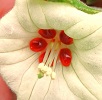
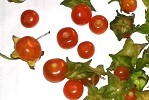
Jaltomato Aguaymanto (Jaltomata herrerae) New for 2025
A jaltomato species bearing small orange berries with a sweet, tangy taste similar to goldenberries (Physalis peruviana). What stands out with this species is also its very unusual blood red nectar found inside each flower. Plant is bushy and grows many side shoots from which hangs the 1-cm berries. May need staking. About 50 to 100 cm tall. Sun to part shade.
See New for 2025




Jicama (Pachyrhizus erosus)
Tropical climber grown for its crunchy, juicy tuber. Sweet, refreshing taste, similar to water chestnut. White flesh, crunchy like an apple. Can be eaten raw or cooked. Used in Mexican and oriental cuisine. Tall vine that can reach more than 2 m tall. Tested in Quebec in 2007 (see below). Start plants inside and harvest tubers around the end of october (when leaves wither). Full sun, with very rich, well drained soil. 150 days.
Packet of 10 seeds: $3,49
The plants grown in zone 5 yielded some large tubers (around 11 cm in diameter) and some smaller (5-6 cm). But all of them tasted great, especially raw, with a pleasant sweet taste. Plants were started in May and planted outside in early June. Can be grown with some success in the north (zone 5) if you give it extra care.
 Kiwano
(Cucumis metuliferus)
Kiwano
(Cucumis metuliferus)(African cucumber, Horned melon)
This climbing vine looks very much like its cucumber relative except for its stinging hairs and its strange, 6-8" orange-yellow fruit covered with horns. The dense, liquid pulp is of a beautiful emerald green, smells like banana and tastes like a mix of lime and cucumber. It can be eaten raw or, preferably, made into a juice or used in sorbets. Grow like cucumbers. Needs warmth and rather long growing season (100 days +). Watch out, foliage stings like stinging nettle.
Packet of 5 seeds: $2,99

 Chinese Lantern
(Physalis alkekengi var. franchetii)
Chinese Lantern
(Physalis alkekengi var. franchetii)Perennial. Known mainly for its decorative husks, this plant
can also be appreciated for its beautiful bright orange berries.
The 2-cm fruits have a pleasant, tart flavor reminiscent of
lemon. Can be used to make jams. Start plants early in February
for first year fruits. Full sun. Zone 4. Warning: can become
invasive with its extended root system.
Packet of 25 seeds: $2,49


Corn Black Waxy (Sticky Corn, Glutinous Corn, Zea mays Group ceratina) New for 2025
Waxy corn originates from Asia and is known for its unique chewy, sticky texture. Can be found in some asian markets, either fresh or frozen. With its unusual texture, this corn can be actually quite fun to chew on (like gummy bears or tapioca pearls). Taste is sweet and similar to sweet corn, though the black strain we offer seems to be a bit sweeter than the other ones. Nice, uniform plants, well-formed ears, about 16-17 cm long. Can sometimes be a bit tricky to time harvest* Black strain, highly pigmented. Black Waxy Corn. About 95 days.
See New for 2025

 Corn Blue Shaman
Corn Blue Shaman Popcorn type with translucent, dark blue kernels. 15-20 cm long. Also used to make blue tortilla chips. Good production (hybrid F1). To make popcorn, just place the dried cob into a paper and put into the microwave oven. 110 days.
Packet of 15 seeds: $2,49

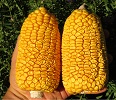
Corn Chilean Green (Maïs du Chili, Choclo Humero, Choclo Pastelero, Maiz Humero) New for 2025
South american strain very well adapted to the north, producing uniquely stout cobs with yellow grains. Very wide ears of corn, with about 22 rows of grain compared to an average of 16 for standard corn. Can be harvested like sweet corn, at the milk stage, ot later, when dried, to make corn nuts. Grows well, good yields. Chilean Green Corn, Choclo Humero. About 90-95 days.
See New for 2025
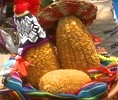


Corn Chullpi (Ch'ullpi, Chulpi, Chulpe, Chulpe Chulpino, Chullpi Amarillo) New for 2025
Andean strain producing small ears measuring 7 to 12 cm long, with a distinct cylindrical-conical to globular shape often reminescent of a pine cone. Used mainly to make cancha*, also called cancha serrana, canchita or maiz tostado (toasted corn), but more widely known in North America as corn nuts. Can also be harvested immature (for miniature corn) or at the milk stage (sweet corn). Large plants with purplish green foliage. Warning: very late 140-145 days. (...)
See New for 2025
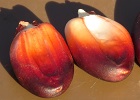


Corn Cuzco Giant Red New for 2025
Peruvian variety with beautiful, huge red grains sometimes reaching over 2 cm long. Share the same lineage as the famous Cuzco Giant White Corn (Urubamaba Blanco, Paraqay, Cusco Gigante*), which has the same type of grain. Used mainly for mote (hominy), cancha (corn nuts) or for choclo (steamed corn). Ears are 15 to 17 cm long. Plants grow to be gigantic, reaching over 4,4 m (14,5 feet!). Warning: very late, at 140 days.
See New for 2025
Indian corn with multicolored ears about 8" long (20 cm). Makes great popcorn. Also good for fall decorations. 5 feet tall. 100 days.
Packet of 20 seeds: $2,49
For a similar variety, see Corn Carousel Indian below.


Corn Japonica Striped (Japonica
Striped
Maize)
Brightly colored foliage with white, yellow and purple stripes.
Click photos for details. Small cobs with dark purple kernels,
15 to 20 cm long. Ornamental foliage. Small plants. Dried cobs
used for decoration and popcorn. From Japan, 1890. 80 days.
Limited supply.
Packet of 15 seeds: $3,49
 Corn
Carousel
Indian
Corn
Carousel
Indian
Ornamental type with tiny cobs, only 12 cm by 2,5 cm. Nice
contrasting, multicolored shades. Makes nice fall decorations.
Can also be ground into flour or popped in the microwave oven.
Short plants, about 120 to 150 cm. 105 days.
Packet of 20 seeds: $2,49
 Corn Peaches and Cream
Corn Peaches and Cream
Sweet corn with white and yellow kernels. Sweet and tasty. 20 cm ears. Well adapted to northern latitudes. Hybrid. Quite early: 80-85 days.
Packet of 15 seeds: $2,99

 Corn Morado
(Peruvian Morado, Maiz Morado)
Corn Morado
(Peruvian Morado, Maiz Morado)Corn variety from the Andes with large dark purple kernels used for making a sweet refreshing drink called chicha morada or chicha de maiz morado. Also used like barley malt for brewing a corn beer of the same name. Very dark-colored, big flattened kernels. This corn needs a very long growing season, definitely more than 120 days. Cannot be grown in Canada (ears begin to form in October!). For long-season countries.
Packet of 10 seeds: $2,49
Popular drink in Lima and along the peruvian coast. The chicha recipes also includes a pineapple, cinnamon, orange peels, lemon, and some other ingredients.


Corn Pescorunto (Pisccorunto, Pisqu Runtu) New for 2025
Peruvian strain whose name in Quechua means "bird's egg", referring to its gorgeous blueish-purple mottled grains (click thumbails for details). Small, stocky ears, 11-12 cm, with a distinct cylindrical-conical to globular shape that is often reminescent of a pine cone. Can be eaten toasted (corn nuts), ground (corn flour), steamed (choclo) or cooked (mote). Tall plants, over 3 m. Alpine variety growing at the highest elevations (+ 3000 m) and under fairly cool temperatures (mean daily average: 4 Celsius).
See New for 2025
Popcorn type with tiny yellow kernels that can be popped into a mini popcorn about 2 times average smaller than (0.8 to 1.5 cm). The long, slender cobs are unique and beautiful; they look like yellow carrots. They are about 15 cm long by 3 cm wide. The plants are quite large, reaching almost 3 m tall. To make novelty popcorn or for decorations.
Packet of 40 seeds: $2,49
 Popcorn Mix
Popcorn MixMixture of several popcorn types: white, yellow, red, purple and blue, with some intermediate tones. You will get different combinations of multi-colored cobs. To make popcorn or for decorations.
Packet of 40 seeds: $2,49

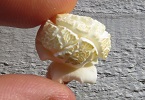
Popcorn Mushroom
There are two types of popcorn: the "butterfly" and the "mushroom" types, depending on whether the popped kernels are flared (butterfly) or rounded (mushroom). So here is a mushroom variety, with kernels that will pop into more rounded flakes (some of them will even be literally mushroom-shaped (right thumbnail)). Good quality popcorn: pops easily to produce good-sized flakes (2 cm), with a more consistent texture and a more pronounced taste than the commercial one. Commonly used to make caramel popcorn. Plants are 2 m tall with medium-sized ears and yellow kernels. 110 days
Packet of 40 seeds: $2,49
Popcorn variety with beautiful ears of shiny red kernels. You can remove kernels to make popcorn or use it whole for decorations. Plants are 2 m tall and with medium size ears, about 20-25 cm long. Packet of 40 seeds: $2,49
 Popcorn Strawberry
Popcorn StrawberrySmall cute cobs with ruby red kernels. Tiny: 5-6 cm. For fall decorations or to make popcorn. Small plants, 1,5 to 1,8 m high. Strawberry Popcorn.100 days.
Packet of 30 seeds: $2,49



Melon Pear (Solanum muricatum, Pepino Melon, Pepino Dulce)
The Melon Pear, aka Pepino Melon, is a native of the Andes producing wonderful fruits with a flavor reminiscent of honeydew melon and pear. Yellow flesh, tender and very juicy. Potato foliage with flowers similar to those of eggplants. (...)
See Exotic plants


Miltomato Vallisto
Dark purple berries with sweet fruity flavor. Larger fruits (1
cm) than Sunberry. Can be eaten fresh. Make a good jam or pie
filling. Highly pigmented. Plants are larger (1 to 1,2 m).
Produce well. Full sun. From Mexico.
Packet of 30+ seeds: $2,99


Nightshade Huckleberry (Morelle
Noire) (Solanum
melanocerasum, scabrum)
Packet of 50 seeds: $2,49
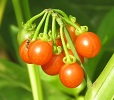
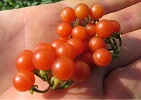
Nightshade Red Berry (Red Nightshade, Solanum villosum ssp. alatum)
Variety with bright scarlet, fully edible fruits, which can be eaten fresh or processed. When fully ripe, their sweet taste is reminiscent of grape, persimmon or kiwi. After harvest, you can let them ripen inside for a few days: their taste seems to get even better. These berries would probably make some tasty jams, either used alone or with other small fruits, such as ground cherries. Fruits are small (0,8 cm) but harvest is continuous and extends from August until frosts. This species is quite large compared to other huckleberries, sunberries and the such; it can reach sometimes over 1,8 m tall. About 70 days.
Packet of 50 seeds: $2,99
 Sunberry
(Sunberry, Wonderberry) (Solanum Burbankii)
Sunberry
(Sunberry, Wonderberry) (Solanum Burbankii)
Smaller huckleberry strain with superior taste. Berries are
naturally sweet and taste like blue grapes. Can be eaten fresh
or to make jam. Smaller plants, 1-2 feet. Tiny, pea-size
berries. Can be grown in pots. Bred by Luther Burbank (1909).
Packet of 50 seeds: $2,49
 Greenberry
Morelle verte
(Solanum opacum)
Greenberry
Morelle verte
(Solanum opacum)Small pea-size green fruits with spicy-sweet taste. Ripen to yellowish green. Gets sweet when real ripe. The small berries look like green sunberries. Crawling plant, 30 to 50 cm high. Rare. From Australia.
Packet of 20 seeds: $2,49
 Okra
Clemson Spineless
(Hibiscus esculentus)
Okra
Clemson Spineless
(Hibiscus esculentus) Okra is a hibiscus grown for its tender seed pods that are harvested before maturity. Spineless strain with long green pods. Early 55-60 days. Plants are between 50 and 120 cm high. Okra pods are used in cajun cooking to make gumbo. Also used in indian cuisine. Needs heat to thrive.
Packet of 20 seeds: $2,49

 Okra Red
(Hibiscus esculentus)
Okra Red
(Hibiscus esculentus)Long red pods follow nice hibiscus-like cream flowers. Pods are
picked young and used cooked in soups, stews and gumbo. Foliage
and stems are red. Ornamental value. 1 m. Heat loving plant.
Full sun. Moderate yield in the north. Packet of 10 seeds: $2,49

Parsnip
Smooth roots with fine texture and sweet taste. About 30 cm long. Sow directly in the ground in spring once the soil has warmed up. Roots are harvested in fall, most often after a frost, which is said to enhance taste. Seed germination is long and can take 2 to 4 weeks. The variety we offer is Harris Model. 125 days.
Packet of 2 g (approximately 400 seeds): $1,99



Peanut Valencia
An early type that can be grown even
in the north (zone 5). Yield is about 20 pods per plant*,
each containing 2 to 4 small pink peanuts. Sow in warm soil
or start inside in pots
(do not disturb roots). Dig out the pods in late september
and let them dry 2 weeks. Then roast in the oven. Very
tasty. Prefers a light, well drained soil. Be careful not to
overwater seeds when sowing**. Full sun.
Packet of 30 seeds: $3,49
**Seeds sown in damp soil tend to rot. To prevent rot, you can pre-soak seeds a few minutes in a solution of water + a few drops of bleach, or use No Damp (or a similar product).
Germination in a wet paper towel works well too. Place wet paper towel in zilpock bag andd keep it in a warm place.

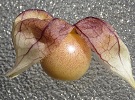
Physalis
minima
A ground cherry look-alike, but with slightly smaller, cream to
yellow fruits, that are often speckled (right thumbnail). Taste
is very sweet, syrupy, reminiscent of candied fruits and
pineapple. Berries stay longer on plants and don't fall as
readily as ground cherries. Once in a while, you might get a
fruit that tastes slightly bitter. "Pygmy Groundcherry". Wild in
some parts of Southeast Asia. Grows well in Quebec. Harvest
starts in August. Plants: 50 cm. Fruits: around 1 cm.
Packet of about 30 seeds: $2,49
Quinoa Rainbow (Chenopodium quinoa)
Annual. Variety with nice multicolored seed heads. Can be used for food or just as an ornamental. Plants are about 1,2-1,8 m high. They have been grown in the Andes for centuries for their nutritious seeds. Selection that can be grown at lower elevations. Blend of pink-red, yellow and orange seedheads. Start plants indoors a few weeks before last frost. 90-110 days.
Packet of +- 100 seeds: $2,99
Seeds contain between 12 an 18% proteins, 8 essential amino acids, iron and calcium (more than milk), and leaves are rich in vitamins and minerals. Seeds are most often cooked like rice, they look and taste then like couscous. Leaves and young shoots are a nutritious and a nice addition to salads. They can also be cooked like spinach. Seeds need to be thoroughly rinsed before use in order to remove saponin, a bitter tasting compound.
 Radish Icicle
Radish Icicle Carrot-shaped white radish with crunchy flesh and mild taste. Short tops. Root about 15 cm long. 30 days.
Packet of 1 g: $2,49

Radish Watermelon
Large white radish, 7 to 8 cm in diameter, with a beautiful pink center. Can be eaten fresh or cooked. Makes very nice slices. Can also be pickled. Pungency seem to decrease as radish grows (so pick them larger for a softer taste). 60 days.
Packet of 2 g: $2,49
 Radish
Zlata
Radish
Zlata Very unusual strain of round radish with yellowish skin! White flesh with mild to medium pungency. Summer radish that will grow well even during summer (tested). From eastern Europe. 40 days. Rare.
Also known as, or very similar to, Helios radish.
Packet of 1 g (around 80 seeds): $3,49
 Rapini
(Brassica rapa)
Rapini
(Brassica rapa)
Fast-growing type of broccoli that can be eaten whole (stems,
leaves and flower heads). Usually sautéed or steamed, but not
eaten raw. Spicy and slightly bitter taste. Smaller flower heads
than the typical broccoli but produces more side shoots. Early
and easy to grow. 40 days. Height: 20 cm. Preferably grown in
spring and fall. Also known as "Broccoli Raab". Popular in
Italy.
Packet of 100 seeds: $2,99
Large yellow roots with purple crowns. Fine flesh, tasty and sweet, turning orange after cooking. Sweeter when harvested after first frosts. Heirloom dating back to the early 1900's. 90 days.
Packet of 100 seeds: $2,49



Sesame Sesamum indicum
Plant grown in the tropical and subtropical regions for its edible seeds. White to pink flowers similar to foxgloves, with some ornamental value, followed by seed pods. Around 1 m high. Needs a well drained soil and full sun. Seed pods begin to dry in fall. In temperate climates, start plants inside, 1 or 2 months before last frosts. 150 days (for seeds). Black-seeded variety.
Packet of 100 seeds: $2,49



Sorghum mix (Sorghum bicolor)
Tall annual grass somewhat similar to corn in shape and size except it has only one terminal, loose seed head. Mix of differently colored seed heads, from reddish to yellow to brown. Used in fall decorations, or to make brooms (hence its name "broom corn"), syrup or molasses (from the stems) or to eat the grain. Very tall plant: 2 to 3 m high. Full sun.
Packet of 50 seeds: $1,99
Wikipedia link on sorghum


Strawberry Spinach (Strawberry Sticks) (Chenopodium capitatum)
Interesting plant bearing bright red, strawberry-like fruits
along its stems. Flavor is unusual, somewhat like a mix of
watermelon and beet (thus its other common name: "beetberry").
Add sugar to taste. Height: 16". Full sun. Sow directly outside
or start 2-3 weeks before last frost. Easy to grow. Can be used
for borders or in containers. Reseeds itself. 60 days.
Packet of about 200 seeds: $2,49



Sweet Lupine (Lupinus albus, White lupine (sweet cultivar, "sweet lupine")
Variety of lupine yielding edible seeds with high nutritional value. Popular in the Mediterranean countries, where it is known by various names (lupini, tremoços, etc.). Lupine seeds are cooked like dried beans and then preserved in brine. They are a popular snack in Portugal and often served with beer. The plant produces flower spikes similar to those of decorative lupins. These are followed by pods similar to those of soybeans, each containing 2 to 7 seeds of about 1 cm. The variety we offer is the sweet lupine, without bitterness. So there is no need to soak the seeds for days (they do not contain any bitter-tasting compounds). The color of the flowers is generally white, but it is variable and can range from blue-purple to white, including intermediate and/or two-tone shades. Prefers a well-drained soil. Full sun. Height: 1 to 1.2 m. Shows some tolerance to cold*. 130 days.
Packet of 20 seeds: $2,99
Lupine (L. albus) is certainly one of the most nutritious plants in the world, with seeds containing up to 40% protein as well as all essential amino acids.
Lupine has already been successfully cultivated on a small scale in Quebec. Links to info: The rise of lupine in Quebec 2nd article 3rd article
Lupine is often compared to soybean because of its high protein content and it is often called "soy of the north". On the other hand, unlike soybean, it does not contain phytoestrogens.
. * Purportedly, seeds could withstand temperatures of -6 C to -8 C during germination. This means you could sow them outside quite early in the spring and thus save time, considering the long growing cycle (130 days). Some recommend sowing outside in early May or at the same time as peas (= end of April, in southern Quebec). The safest method is to start the seedlings indoors, in April, and planting them outside in late May (just make sure not to disturb roots (preferably use peat cups)).


Tarwi (Lupinus mutabilis)
Tarwi is grown in the Andes for its highly nutritious seeds, similar to those of the white lupine. The plant produces flower spikes releasing a delicious sweet scent, followed by pods similar to those of soybeans, inside of which we find the 1-cm white seeds. It is preferable in Quebec to start seedlings indoors a few weeks before last frost in order to get a decent harvest.* Sun to partial shade. 100 cm tall. Grows well in poor soil, fixes nitrogen. Also called "Chocho" or "Andean Lupine". The largest production of Tarwi in the world is located around Lake Titicaca, at 3,800 m elevation. Lupinus mutabilis. Late, 130 days.
Pack of 20 seeds: $2,99
* However, make sure to not disturb roots when planting seedlings outside. Sow preferably in peat pots.
Sowing directly outside is riskier, given the long cycle of this plant (130 days).
For a another edible lupine, which may be more adapted to northern latitudes, see Sweet Lupine above.

 Tomatillo Cisineros
Tomatillo Cisineros
This is a giant strain with fruits reaching up to 6 cm in
diameter. They also have a nice, fine lime taste. Great in
salsas, salsa verde or anywhere limes can be used. For best
flavor, pick the fruits when they are still green. Plants are
about 1 to 1,5 m high and might require some staking. Easy to
grow. Uncommon. A relative of the groundcherries, with fruits
enclosed in a papery husk. Please note that you need to grow
more than one plant at once (needs cross-pollination). 75 days.
Packet of 15 seeds: $2,99
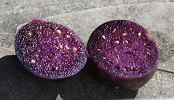
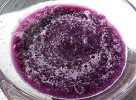

Tomatillo Deep Purple
Give your salsa a purple twist with this hyper pigmented
variety. Indeed, fully matured fruits can be turned into a
colorful puree (middle pic). Once cooked, it takes more of a
pinkish hue (right pic). Use it to prepare either a fresh or
cooked salsa, by adding onions, chiles, etc. Medium size fruit,
about 4-5 cm. About 75-85 days. Full sun preferable.
Packet of around 25 seeds: $2,49

Tomatillo Dirwii
Of
This tomatillo has variable fruits, most often yellowish with a
purple blush. It can be harvested ripe and will still maintain a
firm, crunchy texture. The taste at this stage is also sweeter
and less acidic. So contrary to some "green
tomatillos"(harvested unripe for salsa) this one seems to keep
its eating qualities once fully ripe. Size is variable: 3 to 5
cm. Shade is also variable: from pale yellow/pale green to
yellow, with more or less purple depending on light exposure.
Plants are smaller, about 60 cm high. Aka: "Diiwwii of".
Rare. About 80 jours.
Packet of 20 seeds: $2,99

Tomatillo Dr. Whyche's Yellow
Medium size yellow tomatillo bred by Dr. John Whyche.
Fruits ripen from pale green to lemon yellow. Can be used either
green or yellow (then sweeter). Tart taste, reminiscent of green
apple or lime. For salsa verde and ketchup. Please note that you
need to grow more than one plant at once (needs
cross-pollination). Around 90 days.
Packet of 25 seeds: $2,49
 Tomatillo Yellow Giant
(Mexican Strain)
Tomatillo Yellow Giant
(Mexican Strain)
This variety is also larger than the average tomatillo, with
big yellow fruits reaching 5 cm in diameter. Crunchy, like
apples. Good texture. Zesty taste reminiscent of lemon. Never
bitter. Good for sauces, salsas, chutneys and ketchups. Easy to
grow. Might need some staking. Please note that you need to grow
more than one plant at once (needs cross-pollination).
Packet of 30 seeds: $2,49
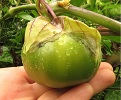 Tomatillo
Gigante Verde
Tomatillo
Gigante Verde
This variety
has a softer
taste, less
acidic and
less tangy. It
is also
claimed to
contain 50%
more sugar
(which makes
sense). Since
its taste is
not as strong
as let's say a
"standard
salsa-type
tomatillo", it
can be more
readily used
like a fresh
fruit. You can
cut it into
pieces or
slices and mix
it with other
fruits or
vegetables.
This variety
also stands
out for its
large-size
fruits (6 cm).
Height:
1 m. Full sun.
Packet of 20
seeds: $2,49



Tomatillo Malinalco (Queen
of Malinalco)
Wonderful bright yellow oblong fruits. Very nice taste
when picked at their peak: quite fruity, with hints of pear, or
even banana and citrus. Almost like a tropical fruit. I enjoyed
eating them right from the garden. Just make sure to pick them
when they get to that deep yellow color (see left thumbnail).
Each plant yields slightly different fruits, but all of them are
elongated and large (up to 12 cm long). Click thumbnails for
details. Plants are 1 m to 1,50 m tall, and may need support. A
real gem from Malinalco, Mexico. Full sun preferable. About 80
days.
Packet of 20 seeds: $2,99
If you enjoy the typical, tangy tomatillo taste
(to make salsa, etc.), just harvest them green or before they
fully turn yellow. When they are ripe, they are more akin to a
table fruit, and you can eat them fresh, if you like their
texture. Don't wait too long though before picking them,
otherwise you'll lose part of your harvest: after they've
reached their peak, they quickly turn pale and mushy and fall
onto the ground. Blossom-end rot: just like some oblong
tomatoes, the first fruits of the season may develop black
tips. Avoid irregular watering and use a calcium-rich
fertilizer.



Tomatillo Purple
(Purple, Purple of Milpa)
Green fruits ripening to purple with a tangy, green apple taste.
Unripe fruits have more of a lemony flavor. 4 to 5 cm Easy to
grow. 1,5 m high. Full sun. You need to grow more than one plant
at once (needs cross-pollination).
Packet of more than 30 seeds: $2,49
Tomatillos are popular in Mexico, where they are used to prepare salsa verde. They make a tasty green ketchup.


Tomatillo Purple Coban
Smaller, purple variety from Coban, Guatemala. About 2 to 4 cm (1 to 2 inches). Green flesh. Easy to grow. You need to grow more than one plant at once (needs cross-pollination). About 90 days.
Packet of 30 seeds: $2,49
Tomatillo San Juanito
Very similar to Cisineros (if not identical), with very large green fruits, weighing up to 100 grams. Needs cross-pollination to set fruits (grow at least 2 plants).
Packet of 30 seeds: $2,49

 Tomatillo Toma Verde
Tomatillo Toma Verde
A relative of the tomatoes and groundcherries, producing green
golfball-size fruits enclosed in a papery husk. Mainly used in
Mexico to prepare the popular salsa
verde. They make also a very tasty green ketchup. Very
easy to grow and quite productive. Needs staking. Please take
note that you need to grow more than one plant (needs
cross-pollination).
Packet of 35 seeds: $1,99
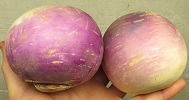
Turnip Purple Top
Large white turnip with a purple top. Can grow up to 12 cm in diameter. White flesh, tender and crispy. Mild peppery flavor reminiscent of radish. Keeps well after harvest. "Purple Top White Globe". Turnips are best grown in spring and fall. 50 days.
Packet of 1 g (approximately 300 seeds): $1,99
 Turnip White
Egg
Turnip White
Egg Small turnip, round-oval, with tender and juicy flesh. Slightly peppery flavor reminiscent of radish. This variety can be harvested when it is the size of a golf ball, or later, when it reaches 7 cm in diameter. It can be eaten fresh or cooked. Cultivar "White Egg". Turnips are best grown in spring and fall. 50 days.
Packet of 1 g (approximately 300 seeds): $1,99


